Combustion Modes and Unsteady Characteristics during the Condition Transition of a Scramjet Combustor
Abstract
:1. Introduction
2. Materials and Methods
2.1. Experimental Setup
2.2. Computational Setup
3. Results and Discussion
3.1. Combustion Modes
3.2. Transition Process of the Stable Combustion Mode
4. Conclusions
- (1)
- With the increase in the injection pressure drop, three combustion modes appear during the condition transition of a scramjet, namely stable combustion mode, combustion oscillation mode, and flame blowout mode. When the injection pressure drop increases during the stable combustion modes, the area of the flame and the light intensity decrease gradually, and the wall pressure decreases accordingly after the condition transition.
- (2)
- An obvious intermittent local flame extinction phenomenon can be observed downstream of the cavity near the blowout limits. This combustion oscillation mode is accompanied by alternate local extinction and reignition phenomena. With a further increase in the injection pressure drop, an obvious flame blowout phenomenon occurs during the condition transition.
- (3)
- In the stable combustion modes, the combustion intensity deceases gradually as the injection pressure decreases during the transition process. When the injection pressure drop is relatively high, the flame-stabilized mode changes during the transition process, accompanied by a change in the distribution of wall pressure.
Author Contributions
Funding
Institutional Review Board Statement
Informed Consent Statement
Data Availability Statement
Conflicts of Interest
References
- Neill, S.M.; Pesyridis, A. Modeling of Supersonic Combustion Systems for Sustained Hypersonic Flight. Energies 2017, 10, 1900. [Google Scholar] [CrossRef] [Green Version]
- Choubey, G.; Pandey, K.M.; Maji, A.; Deshamukhya, T. A brief review on the recent advances in scramjet engine. In Proceedings of the International Conference on Functional Materials, Characterization, Solid State Physics, Power, Thermal and Combustion Energy, Andhra Pradesh, India, 7–8 April 2017; Malla, S.G., Sanjay, S.D., Khan, M.P., Eds.; AIP Conference Proceedings: Melville, NY, USA, 2017; Volume 1859. [Google Scholar]
- Urzay, J. Supersonic Combustion in Air-Breathing Propulsion Systems for Hypersonic Flight. In Annual Review of Fluid Mechanics; Davis, S.H., Moin, P., Eds.; Annual Review of Fluid Mechanics: Palo Alto, CA, USA, 2018; Volume 50, pp. 593–627. [Google Scholar]
- Jeong, S.-M.; Choi, J.-Y. Combined Diagnostic Analysis of Dynamic Combustion Characteristics in a Scramjet Engine. Energies 2020, 13, 4029. [Google Scholar] [CrossRef]
- Wang, Z.; Wang, H.; Sun, M. Review of cavity-stabilized combustion for scramjet applications. Proc. Inst. Mech. Eng. Part G J. Aerosp. Eng. 2014, 228, 2718–2735. [Google Scholar] [CrossRef]
- Kummitha, O.R.; Pandey, K.M.; Gupta, R. Optimization of scramjet performance with different fuel injection techniques and flame holder cavities. Acta Astronaut. 2018, 152, 908–919. [Google Scholar] [CrossRef]
- Tuncer, O. Combustion in a Ramjet Combustor with Cavity Flame Holder. In Proceedings of the 48th AIAA Aerospace Sciences Meeting Including the New Horizons Forum and Aerospace Exposition 2010, Orlando, FL, USA, 4–7 January 2010; Volume 20, pp. 18086–18097. [Google Scholar]
- Liu, C.; Sun, M.; Wang, H.; Yang, L.; An, B.; Pan, Y. Ignition and flame stabilization characteristics in an ethylene-fueled scramjet combustor. Aerosp. Sci. Technol. 2020, 106, 106186. [Google Scholar] [CrossRef]
- Micka, D.J.; Driscoll, J.F. Combustion characteristics of a dual-mode scramjet combustor with cavity flameholder. Proc. Combust. Inst. 2009, 32, 2397–2404. [Google Scholar] [CrossRef]
- Wang, Y.; Wang, Z.; Sun, M.; Wang, H. Combustion stabilization modes in a hydrogen-fueled scramjet combustor at high stagnation temperature. Acta Astronaut. 2018, 152, 112–122. [Google Scholar] [CrossRef]
- Jialing, L.; Shunhua, Y.; Xiyao, W.; Hongbin, L. Analysis and Correlation of Flame Stability Limits in Supersonic Flow with Cavity Flameholder. In Proceedings of the 18th AIAA/3AF International Space Planes and Hypersonic Systems and Technologies Conference 2012, Tours, France, 24–28 September 2012; Volume 3, pp. 1691–1699. [Google Scholar]
- Wang, H.; Wang, Z.; Sun, M.; Wu, H. Combustion modes of hydrogen jet combustion in a cavity-based supersonic combustor. Int. J. Hydrogen Energy 2013, 38, 12078–12089. [Google Scholar] [CrossRef]
- Tian, Y.; Yang, S.; Le, J.; Su, T.; Yue, M.; Zhong, F.; Tian, X. Investigation of combustion and flame stabilization modes in a hydrogen fueled scramjet combustor. Int. J. Hydrogen Energy 2016, 41, 19218–19230. [Google Scholar] [CrossRef]
- Aguilera, C.; Yu, K.H. Scramjet to ramjet transition in a dual-mode combustor with fin-guided injection. Proc. Combust. Inst. 2017, 36, 2911–2918. [Google Scholar] [CrossRef]
- Li, J.; Wang, K.; Jiao, G.; Luo, J.; Song, W. Experimental Study on Mode Transition in a Dual-Mode Scramjet Combustor. Combust. Sci. Technol. 2020, 192, 852–870. [Google Scholar] [CrossRef]
- Ouyang, H.; Liu, W.; Sun, M. The large-amplitude combustion oscillation in a single-side expansion scramjet combustor. Acta Astronaut. 2015, 117, 90–98. [Google Scholar] [CrossRef]
- Sartor, F.; Mettot, C.; Bur, R.; Sipp, D. Unsteadiness in transonic shock-wave/boundary-layer interactions: Experimental investigation and global stability analysis. J. Fluid Mech. 2015, 781, 550–577. [Google Scholar] [CrossRef] [Green Version]
- Guiho, F.; Alizard, F.; Robinet, J.C. Instabilities in oblique shock wave/laminar boundary-layer interactions. J. Fluid Mech. 2016, 789, 1–35. [Google Scholar] [CrossRef] [Green Version]
- Lin, K.-C.; Jackson, K.; Behdadnia, R.; Jackson, T.A.; Ma, F.; Yang, V. Acoustic Characterization of an Ethylene-Fueled Scramjet Combustor with a Cavity Flameholder. J. Propuls. Power 2010, 26, 1161–1169. [Google Scholar] [CrossRef] [Green Version]
- Wang, Z.-g.; Sun, M.-b.; Wang, H.-b.; Yu, J.-f.; Liang, J.-h.; Zhuang, F.-c. Mixing-related low frequency oscillation of combustion in an ethylene-fueled supersonic combustor. Proc. Combust. Inst. 2015, 35, 2137–2144. [Google Scholar] [CrossRef]
- Wang, H.; Wang, Z.; Sun, M. Experimental study of oscillations in a scramjet combustor with cavity flameholders. Exp. Therm. Fluid Sci. 2013, 45, 259–263. [Google Scholar] [CrossRef]
- Wang, T.; Li, G.; Yang, Y.; Wang, Z.; Cai, Z.; Sun, M. Combustion modes periodical transition in a hydrogen-fueled scramjet combustor with rear-wall-expansion cavity flameholder. Int. J. Hydrogen Energy 2020, 45, 3209–3215. [Google Scholar] [CrossRef]
- Ouyang, H.; Liu, W.; Sun, M. Parametric study of combustion oscillation in a single-side expansion scramjet combustor. Acta Astronaut. 2016, 127, 603–613. [Google Scholar] [CrossRef]
- Ouyang, H.; Liu, W.; Sun, M. The influence of cavity parameters on the combustion oscillation in a single-side expansion scramjet combustor. Acta Astronaut. 2017, 137, 52–59. [Google Scholar] [CrossRef]
- Song, X.; Wang, H.; Sun, M.; Cai, Z.; Liu, C.; Yu, J. Mixing and combustion characteristics in a cavity-based supersonic combustor with different injection schemes. Acta Astronaut. 2019, 159, 584–592. [Google Scholar] [CrossRef]
- Tian, Y.; Yang, S.; Le, J.; Zhong, F.; Tian, X. Investigation of the effects of fuel injector locations on ignition and flame stabilization in a kerosene fueled scramjet combustor. Aerosp. Sci. Technol. 2017, 70, 310–316. [Google Scholar] [CrossRef]
- Kirik, J.W.; Goyne, C.P.; McDaniel, J.C.; Rockwell, R.D. Aerodynamics of Lean Blowout in a Premixed Dual-Mode Scramjet. J. Propuls. Power 2018, 34, 819–822. [Google Scholar] [CrossRef]
- Kirik, J.W.; Goyne, C.P.; McDaniel, J.C.; Rockwell, R.D.; Cantu, L.M.L.; Gallo, E.C.A.; Cutler, A.D. Aerodynamic Characterization of a Cavity Flameholder in a Premixed Dual-Mode Scramjet. J. Propuls. Power 2018, 34, 739–749. [Google Scholar] [CrossRef]
- Nilsson, T.; Carlsson, H.; Yu, R.; Bai, X.-S. Structures of turbulent premixed flames in the high Karlovitz number regime—DNS analysis. Fuel 2018, 216, 627–638. [Google Scholar] [CrossRef]
- Di Sarli, V.; Di Benedetto, A.; Russo, G. Large Eddy Simulation of transient premixed flame-vortex interactions in gas explosions. Chem. Eng. Sci. 2012, 71, 539–551. [Google Scholar] [CrossRef]
- Savard, B.; Bobbitt, B.; Blanquart, G. Structure of a high Karlovitz n-C7H16 premixed turbulent flame. Proc. Combust. Inst. 2015, 35, 1377–1384. [Google Scholar] [CrossRef] [Green Version]
- Liu, C.; Wang, Z.; Sun, M.; Wang, H.; Li, P. Characteristics of a Cavity-Stabilized Hydrogen Jet Flame in a Model Scramjet Combustor. AIAA J. 2019, 57, 1–12. [Google Scholar] [CrossRef]
- Rasmussen, C.C.; Driscoll, J.F.; Hsu, K.Y.; Donbar, J.M.; Gruber, M.R.; Carter, C.D. Stability limits of cavity-stabilized flames in supersonic flow. Proc. Combust. Inst. 2005, 30, 2825–2833. [Google Scholar] [CrossRef]
- Wang, Y.; Song, W. Experimental investigation of influence factors on flame holding in a supersonic combustor. Aerosp. Sci. Technol. 2019, 85, 180–186. [Google Scholar] [CrossRef]
- Rasmussen, C.; Driscoll, J. Blowout Limits of Flames in High-Speed Airflows: Critical Damkohler Number. In Proceedings of the 44th AIAA/ASME/SAE/ASEE Joint Propulsion Conference & Exhibit (Joint Propulsion Conferences), Hartford, CT, USA, 21–23 July 2008; American Institute of Aeronautics and Astronautics: Reston, VA, USA, 2008. [Google Scholar]
- Zhang, T.; Wang, J.; Qi, L.; Fan, X.; Zhang, P. Blowout Limits of Cavity-Stabilized Flame of Supercritical Kerosene in Supersonic Combustors. J. Propuls. Power 2014, 30, 1161–1166. [Google Scholar] [CrossRef] [Green Version]
- Zhu, S.; Xu, X.; Ji, P. Flame Stabilization and Propagation in Dual-Mode Scramjet with Staged-Strut Injectors. AIAA J. 2017, 55, 171–179. [Google Scholar] [CrossRef]
- Zhu, S.H.; Xu, X. Experimental Study on Flame Transition in a Two-Stage Struts Dual-Mode Scramjet. J. Aerosp. Eng. 2017, 30. [Google Scholar] [CrossRef]
- Xue, R.; Xu, M.; Bai, C.; Weng, C.; Xu, C. Study on transient process of mode transition in a scramjet combustor with pilot hydrogen. Int. J. Energy Res. 2018, 42, 2481–2493. [Google Scholar] [CrossRef]
- Huang, W.; Li, L.-q.; Yan, L.; Liao, L. Numerical exploration of mixing and, combustion in a dual-mode combustor with backward-facing steps. Acta Astronaut. 2016, 127, 572–578. [Google Scholar] [CrossRef] [Green Version]
- Smolik, M.; Skala, V.; Nedved, O. A Comparative Study of LOWESS and RBF Approximations for Visualization. In Lecture Notes in Computer Science, Proceedings of the Computational Science and Its Applications—ICCSA 2016, pt. II, Beijing, China, 4–7 July 2016; Gervasi, O., Murgante, B., Misra, S., Rocha, A., Torre, C.M., Tanier, D., Apduhan, B.O., Stankova, E., Wang, S., Eds.; Springer: Cham, Switzerland, 2016; Volume 9787, pp. 405–419. [Google Scholar]

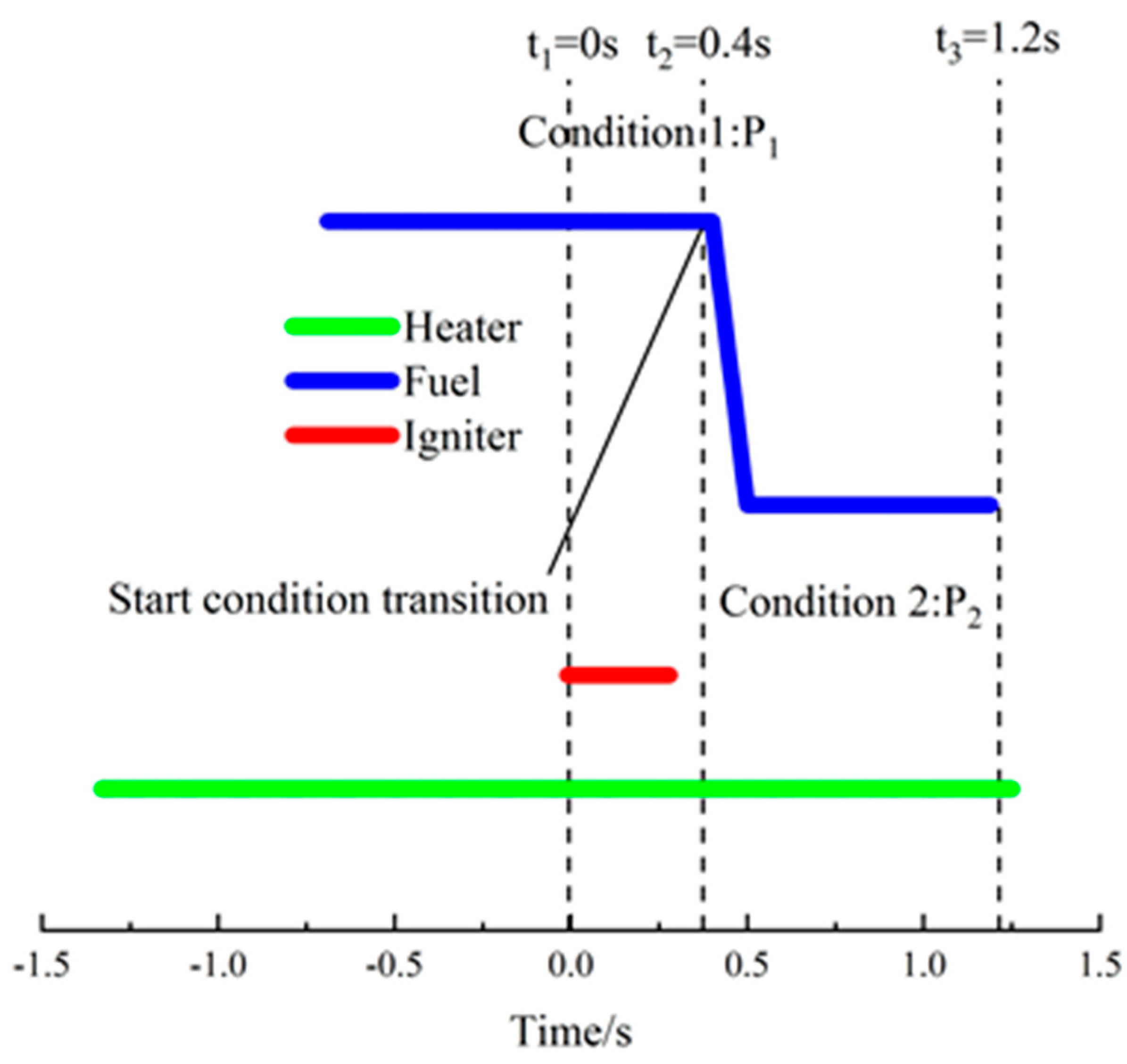

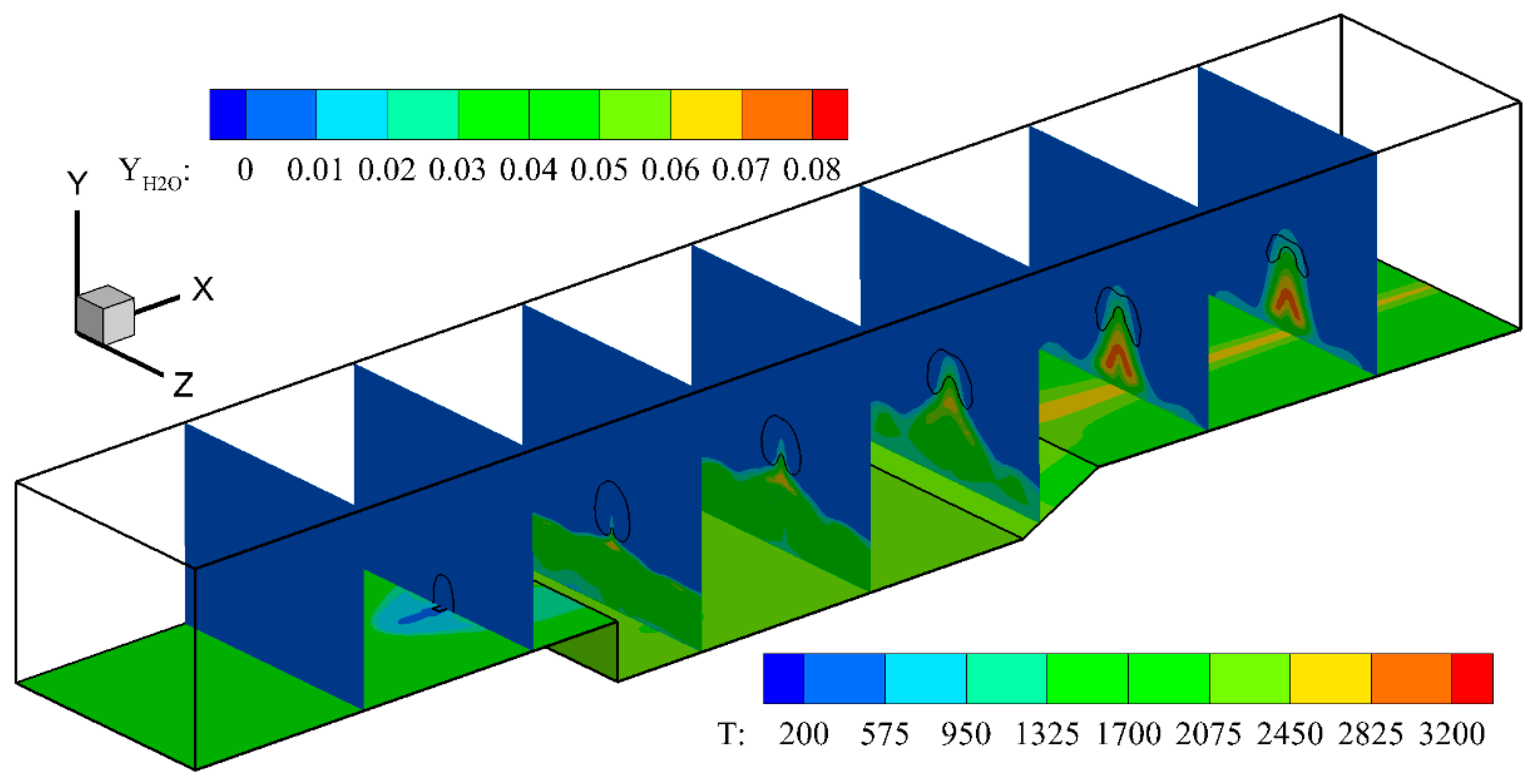

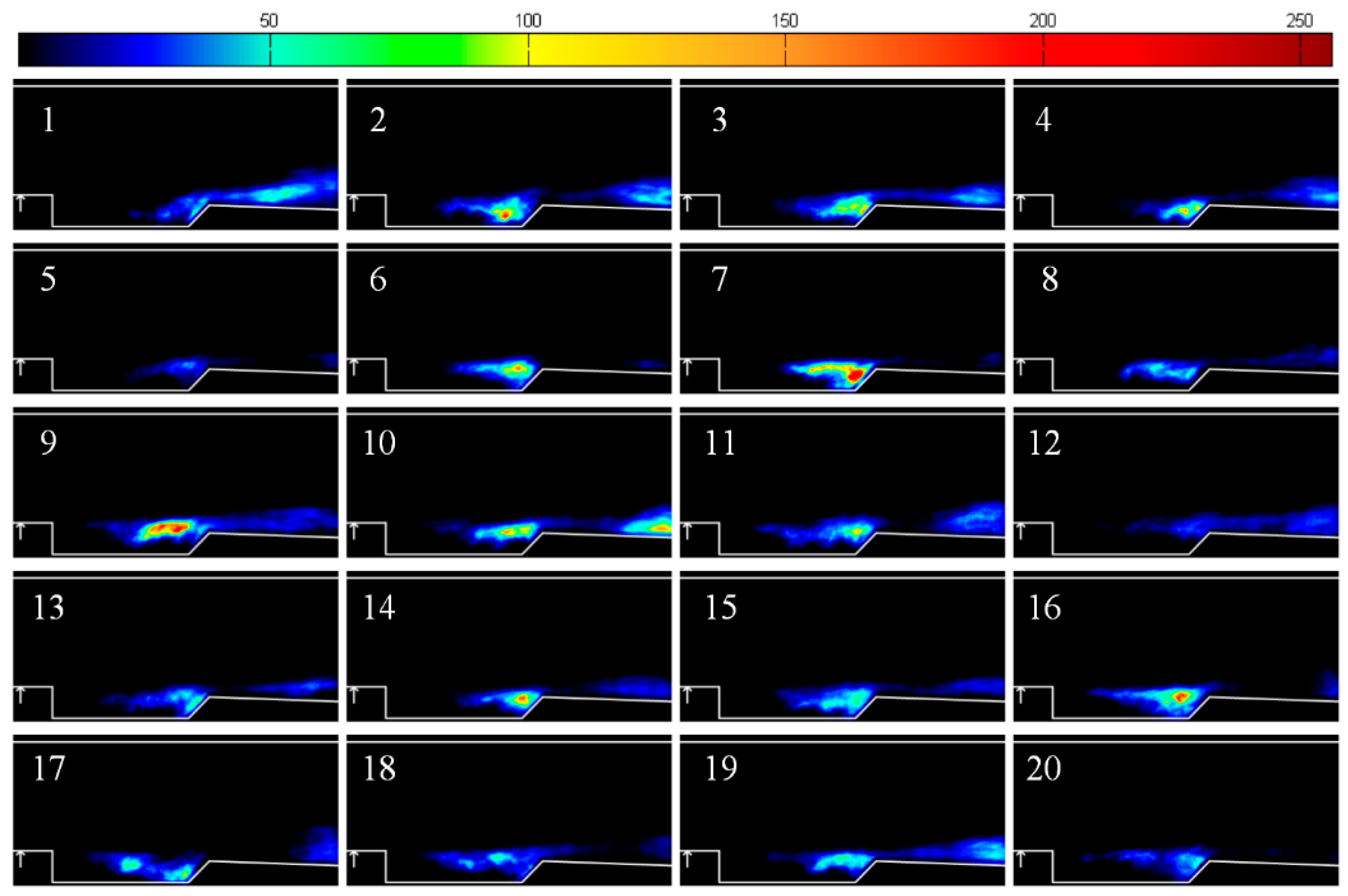
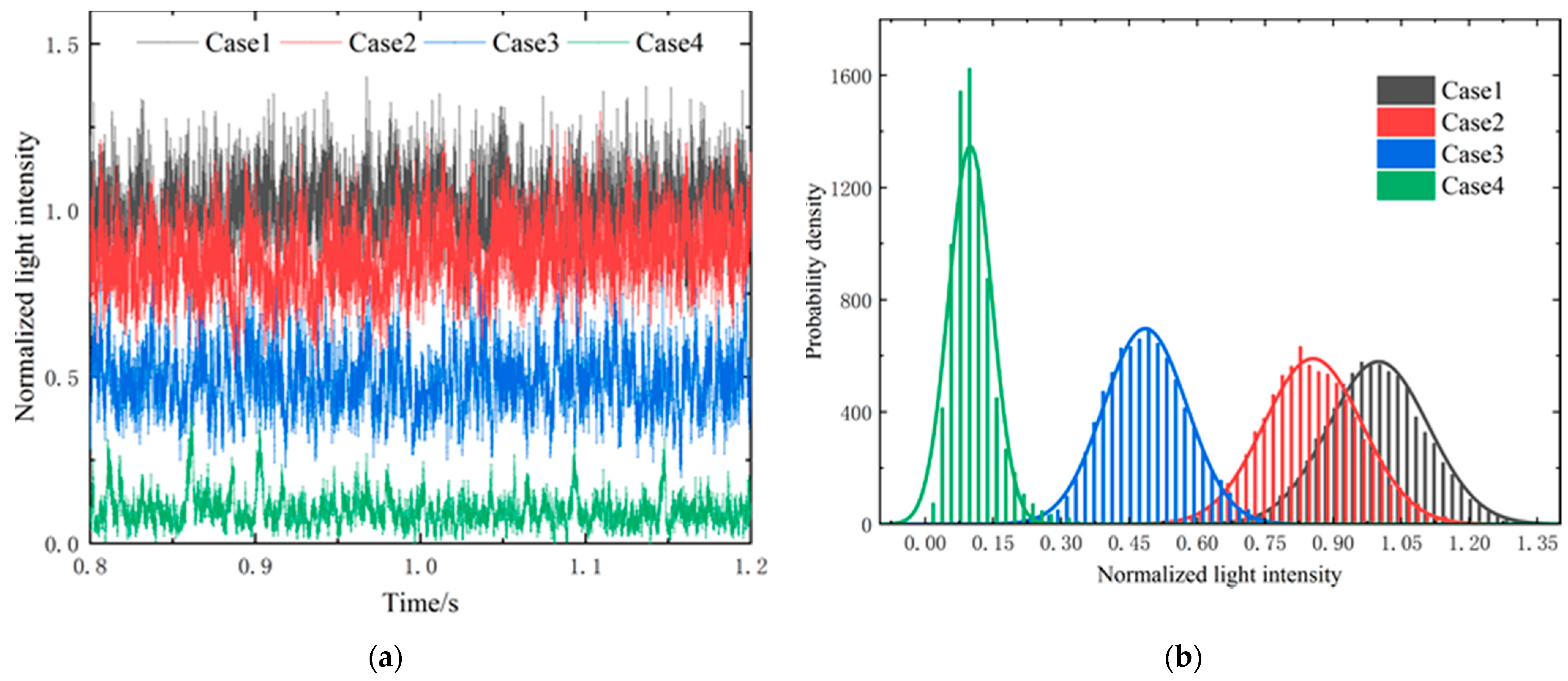


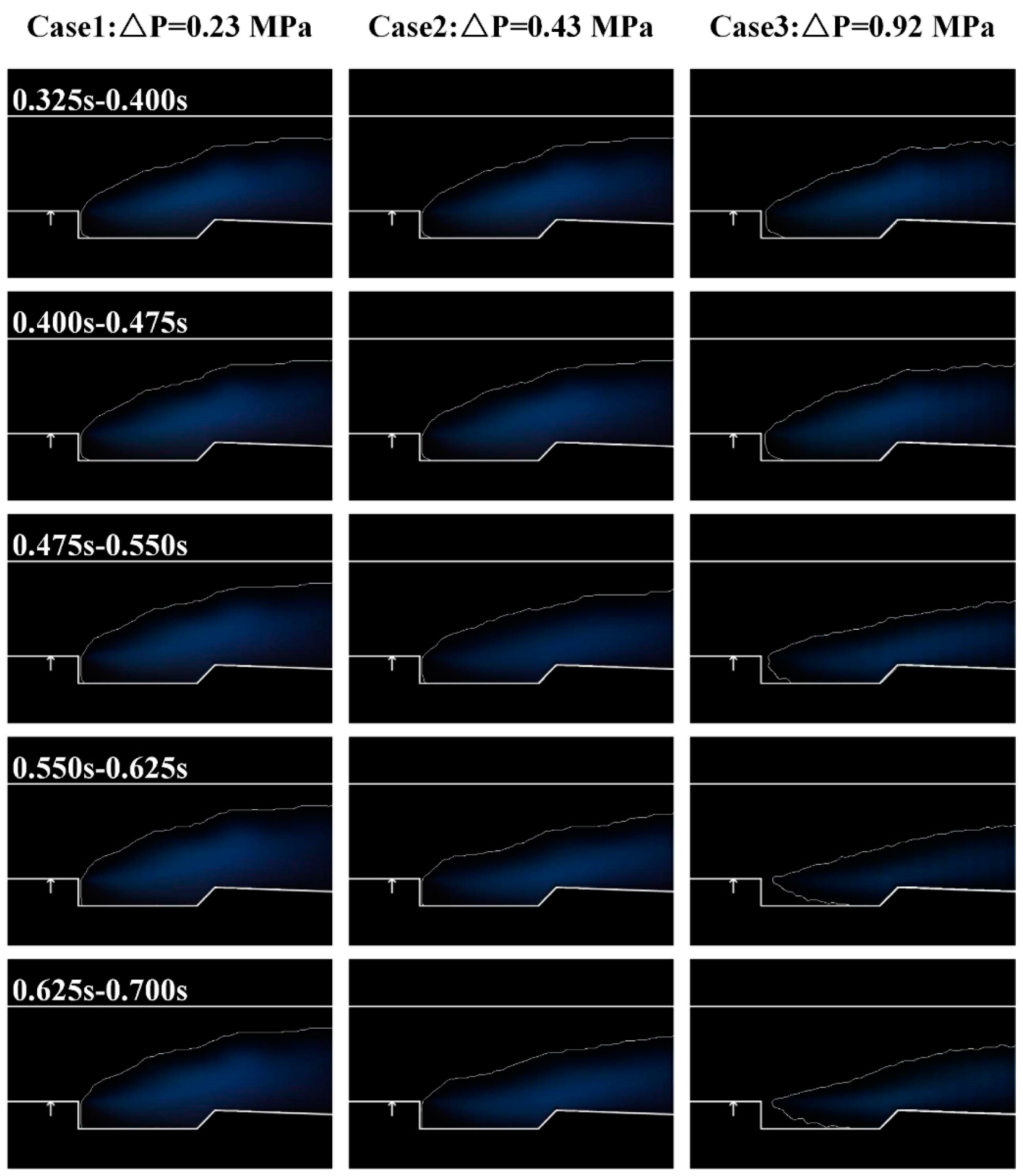


| Case No. | P1 (MPa) | P2 (MPa) | Pressure Drop (MPa) | Equivalence Ratio | Flame Structure |
|---|---|---|---|---|---|
| 1 | 3.67 | 3.44 | 0.23 | 0.244→0.217 | stabilization |
| 2 | 3.67 | 3.24 | 0.43 | 0.244→0.205 | |
| 3 | 3.69 | 2.77 | 0.92 | 0.244→0.180 | |
| 4 | 3.67 | 2.32 | 1.35 | 0.244→0.160 | oscillation |
| 5 | 3.64 | 2.24 | 1.42 | 0.244→0.153 | blowout |
Publisher’s Note: MDPI stays neutral with regard to jurisdictional claims in published maps and institutional affiliations. |
© 2021 by the authors. Licensee MDPI, Basel, Switzerland. This article is an open access article distributed under the terms and conditions of the Creative Commons Attribution (CC BY) license (https://creativecommons.org/licenses/by/4.0/).
Share and Cite
Jia, D.; Pan, Y.; Wang, N.; Liu, C.; Yang, K. Combustion Modes and Unsteady Characteristics during the Condition Transition of a Scramjet Combustor. Energies 2021, 14, 2522. https://doi.org/10.3390/en14092522
Jia D, Pan Y, Wang N, Liu C, Yang K. Combustion Modes and Unsteady Characteristics during the Condition Transition of a Scramjet Combustor. Energies. 2021; 14(9):2522. https://doi.org/10.3390/en14092522
Chicago/Turabian StyleJia, Dongpeng, Yu Pan, Ning Wang, Chaoyang Liu, and Kai Yang. 2021. "Combustion Modes and Unsteady Characteristics during the Condition Transition of a Scramjet Combustor" Energies 14, no. 9: 2522. https://doi.org/10.3390/en14092522





